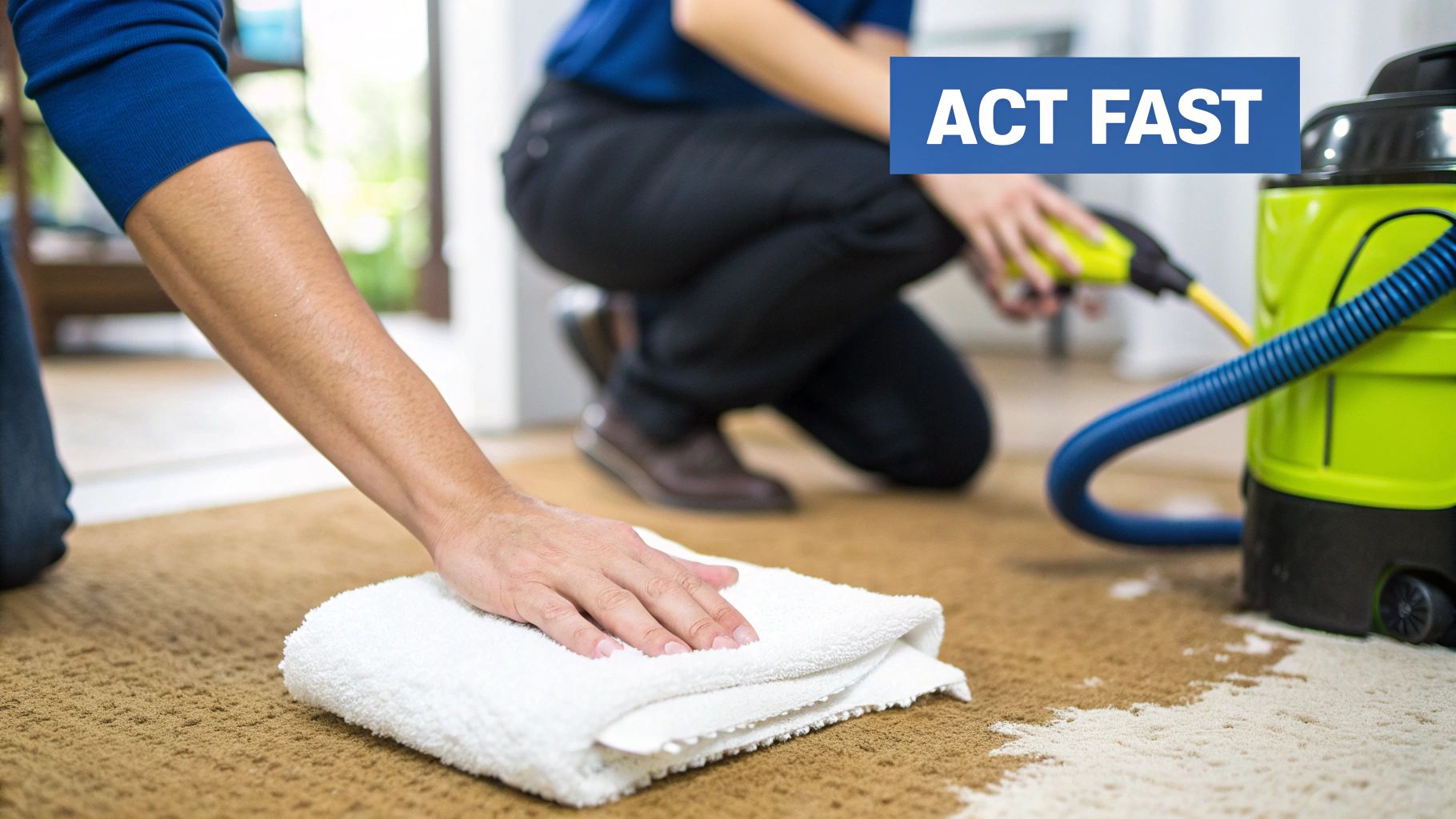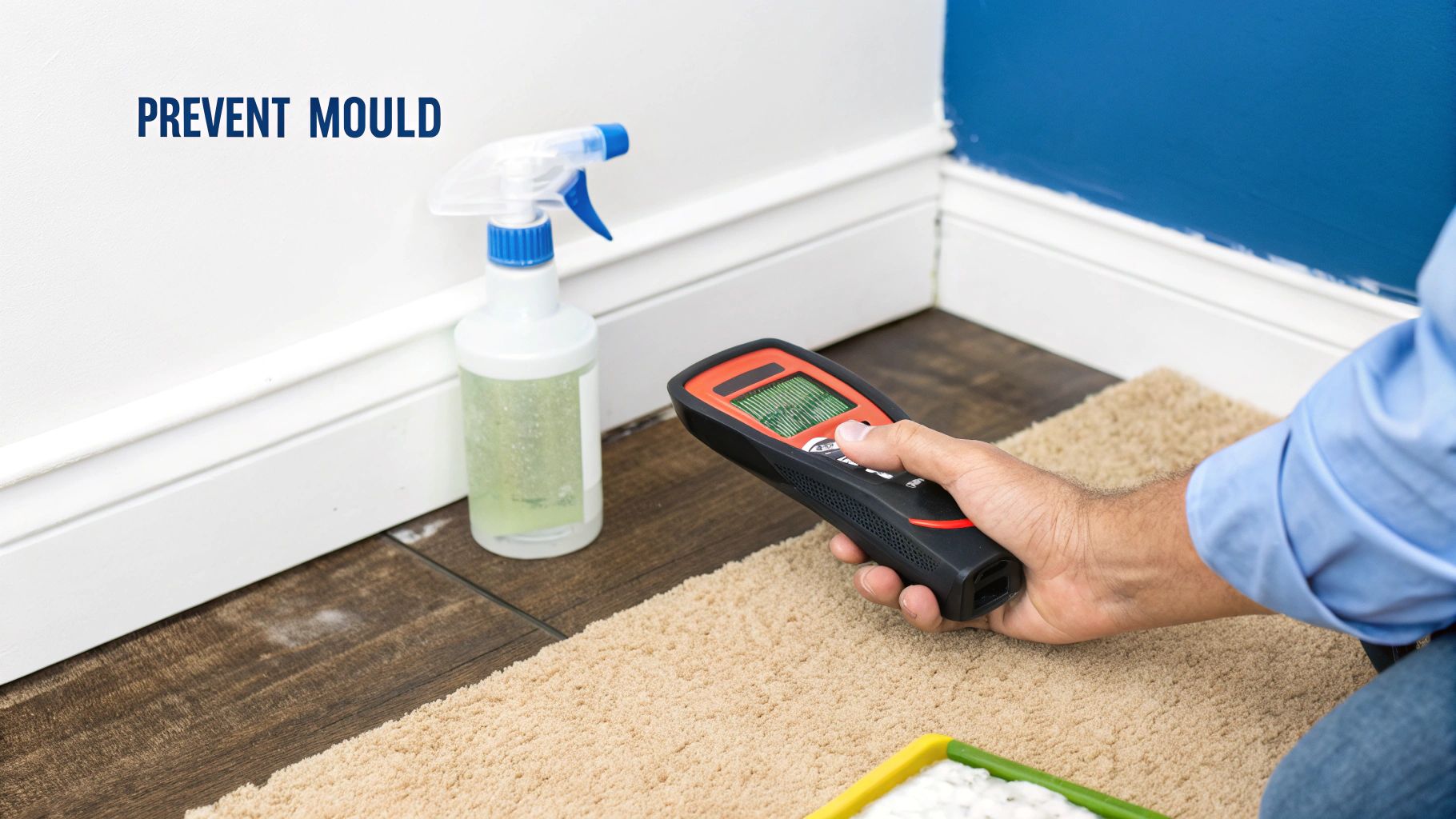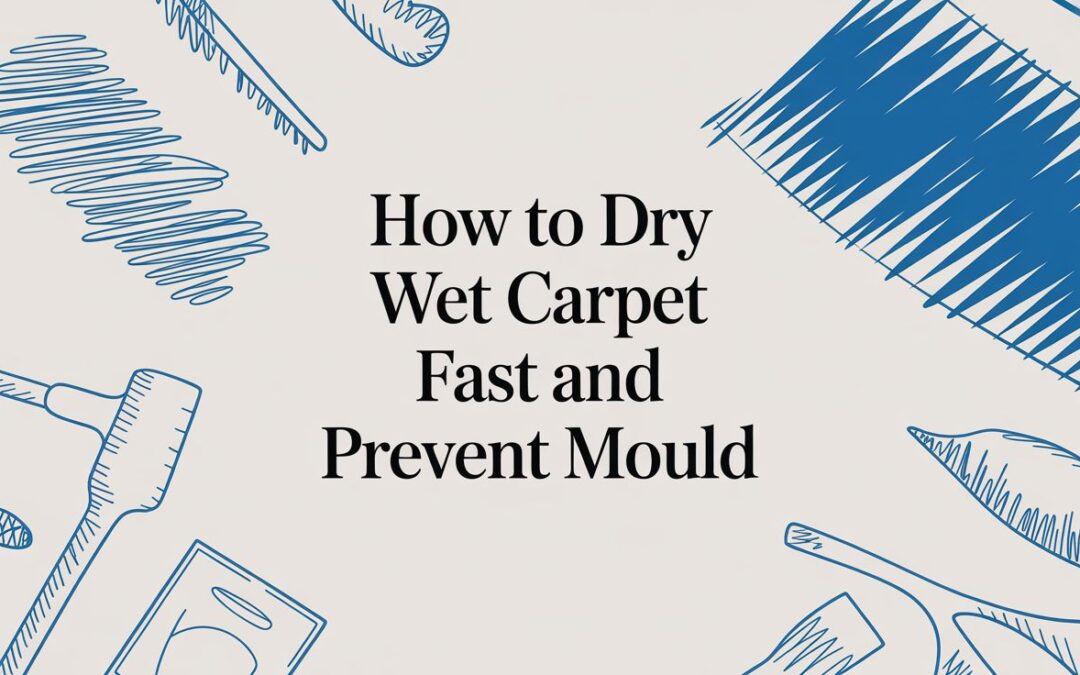That sinking feeling when you step on a squishy, wet patch of carpet is unmistakable. Whether it's from a burst pipe, a leaking appliance, or a storm that's gotten the better of your home, your actions in the first hour are absolutely crucial.
Acting fast doesn't just save your carpet; it protects your home's structure and your family's health from the risk of mould, which can start growing in as little as 24 to 48 hours. Here’s what you need to do right away.
Your Immediate Response to a Wet Carpet

Before you even think about drying anything, you need a clear, calm plan. Getting the first few steps right sets you up for a successful recovery and prevents a small problem from spiralling into a major, expensive headache.
When you first discover a wet carpet, it's easy to feel overwhelmed. To help you focus, we've put together a quick checklist covering the most critical tasks for the first 30 minutes. Following these steps in order will ensure you address safety first and stop the problem from getting worse.
Wet Carpet Emergency Checklist
| Action Step | Why It Matters | Tools Needed |
|---|---|---|
| Stop the water source. | This is the top priority. No amount of drying will help if more water is coming in. | Your hands, maybe a torch to find the shut-off valve. |
| Turn off the power. | Water and electricity are a lethal mix. This prevents electric shock from wet appliances or submerged power points. | Access to your circuit breaker box. |
| Assess the water type. | Is it clean water (e.g., from a tap) or contaminated (e.g., sewage backup, floodwater)? Contaminated water requires professional help. | Your eyes and nose. If it's dark or smells bad, assume it's unsafe. |
| Move furniture & belongings. | Get everything off the wet carpet to prevent furniture stains, rust, and further damage to your items. | Your hands, aluminium foil, or wooden blocks. |
| Begin initial water removal. | Extract as much water as you can immediately to kickstart the drying process and reduce mould risk. | Old towels, a wet-dry vacuum, or a mop and bucket. |
This checklist isn't exhaustive, but it covers the immediate, non-negotiable actions that can make all the difference. Once these are done, you can move on to the more detailed drying process.
Find and Stop the Water Source
First things first: you have to stop more water from coming in. Trace the water back to its origin. Is it an overflowing washing machine, a leaky pipe under the sink, or a drip from a faulty roof seal during a storm?
If you’re dealing with a plumbing leak, find the main water valve to your home and shut it off immediately. This single action can turn a potential catastrophe into a manageable inconvenience. For other sources, like a roof leak, do what you can to contain it with buckets until it can be properly fixed.
Prioritise Safety Above All Else
Water and electricity are a dangerous combination. Before you start any cleanup, head straight to your circuit breaker and switch off the power to the affected room and any adjacent areas. This step is non-negotiable. It completely eliminates the risk of electric shock from submerged power points or wet appliances.
It's also important to consider the type of water. If it’s from a sewer backup or outside floodwaters, assume it's contaminated with bacteria and other hazards. In these situations, it's best to avoid all contact and call a professional water damage restoration service, like Right Price Carpet Cleaning, to handle it safely.
Key Takeaway: Your initial goals are simple but critical: stop the leak, shut off the power, and assess the situation. Rushing into drying without addressing the source and safety risks will only create more problems down the line.
Clear the Area and Protect Furniture
Once the area is safe, get everything off the wet carpet. Move all furniture, electronics, and personal items out of the room. Water can permanently warp wooden furniture legs, cause dyes from fabrics to bleed into your carpet, and completely ruin electronics.
What about heavy items that are a pain to move?
- You can place small wooden blocks under the legs to lift them off the wet surface.
- Another trick is to put squares of aluminium foil under the legs. This creates a barrier that prevents rust marks or furniture stains from transferring onto the wet fibres.
Clearing the room not only protects your belongings but also gives you the unobstructed space you need to start extracting water and setting up fans effectively.
Choosing the Right Tools for the Job
Successfully tackling a wet carpet really hinges on having the right equipment. Trying to dry a flooded room with a standard household fan is like trying to empty a swimming pool with a bucket—it’s just not going to cut it. The tools you need will depend entirely on the scale of the water damage.
For a minor spill, like a knocked-over glass of water, the stuff you already have at home is usually enough. A good wet-dry vacuum and a stack of super-absorbent towels can handle the initial water extraction. After that, setting up a few standard box fans should provide enough airflow to dry out the small, damp patch.
But the game changes completely when you're dealing with a large, saturated area from something like a burst pipe or a minor flood. In these situations, professional-grade gear isn't just a suggestion; it's an absolute necessity.
When to Hire Professional Drying Equipment
If the water has soaked right through to the underlay or is covering a big chunk of the room, your household tools simply won't have the power to prevent mould from taking hold. This is your cue to bring in the heavy-duty equipment.
-
High-Velocity Air Movers: These are a world away from your average fan. Often called "carpet blowers," they're specifically designed to blast a high-speed, concentrated stream of air directly across the carpet's surface. This powerful airflow dramatically speeds up evaporation, pulling moisture from deep within the carpet fibres and the underlay.
-
Commercial Dehumidifiers: While air movers get moisture into the air, a dehumidifier’s job is to pull it out of the air. A commercial-grade unit can remove dozens of litres of water from the atmosphere every day. This is crucial for lowering the room's humidity and stopping all that moisture from just reabsorbing into your walls, furniture, and back into the carpet.
-
Moisture Meters: Think of this as your secret weapon for knowing when the job is actually done. A moisture meter has pins you can press into the carpet, underlay, and even the subfloor to get a precise reading of the moisture content. It takes all the guesswork out of drying and confirms when an area is truly bone-dry, preventing hidden mould from growing down the track.
A classic mistake is thinking the carpet is dry just because it feels dry to the touch. The underlay and subfloor can hold onto moisture for weeks, creating a perfect breeding ground for mould long after you've put all the furniture back.
Sourcing and Using Equipment in Australia
So, where do you get your hands on this kind of gear? Most local hire shops, like Kennards Hire or Coates, will have air movers and dehumidifiers available for daily or weekly rental. You can expect to pay around $40-$80 per day for each piece of equipment, depending on its size and power.
When you're setting everything up, place the air movers at an angle to the wall. This helps create a circular airflow, or a "drying vortex," that covers the whole room. Pop the dehumidifier in the centre of the space and make sure its drain hose leads to a sink or a bucket that you can empty regularly. By combining these tools, you create an aggressive drying environment that gives you the best possible chance of saving your carpet.
Spills vs. Floods: Knowing Which Drying Strategy to Use
The way you tackle a wet carpet should be worlds apart depending on whether you’re dealing with a tipped-over glass of water or a room soaked from a burst pipe. A small, localised spill is usually just a minor inconvenience, something you can sort out with a few things you already have at home.
On the other hand, a proper flood requires a much more aggressive and methodical approach to head off serious, long-term damage like mould and rot.
Getting this right is crucial. If you treat a flood like a small spill, you're practically inviting mould and ruined underlay. But calling in the big guns for a minor damp patch is just overkill. Let’s break down the right way to handle each situation.
This infographic gives you a quick visual on the tools you'll need, scaling up from a small damp spot to a completely saturated carpet.

As you can see, the game plan changes pretty dramatically from simple household items for minor spills to heavy-duty equipment once things get serious.
How to Handle Minor Spills and Small Wet Patches
When you're faced with a small, surface-level wet spot, your mission is simple: blot, extract, and get some air moving. You still want to act fast, but the process itself is pretty straightforward.
-
Blot Immediately: Grab some clean, dry towels and press down firmly on the wet patch. Whatever you do, don't rub. Rubbing just grinds the moisture deeper and can fray the carpet fibres. For extra pressure, stand on the towels. Keep swapping them for dry ones until you’re not pulling much water out anymore.
-
Use a Wet-Dry Vac: Once you’ve blotted up all you can, go over the area with a wet-dry vacuum. This will pull out the moisture lurking deeper in the pile. Make sure you pass over the spot slowly from a few different directions to be thorough.
-
Get the Air Circulating: Point a regular household fan directly at the damp area. Popping it up on a box or a chair can help the air flow more effectively across the carpet surface. Leave it running for at least 24 hours, even if the spot feels dry to the touch.
For spills that haven't managed to soak through to the underlay, this three-pronged attack is usually all you need.
The Game Plan for Saturated Carpets and Major Flooding
When your carpet and the underlay beneath it are completely saturated, you've got to step up your game significantly. This is what we see after major storms or appliance failures, which create huge demand for professional help. The Australian carpet cleaning market, valued at around AUD 611.5 million, often sees big spikes in demand after flooding events in states like Queensland and New South Wales. You can explore more insights on the Australian carpet cleaning market to see how these trends play out.
With this level of water damage, the goal shifts to aggressive water removal and, most importantly, drying out those hidden layers.
Expert Insight: The biggest mistake I see homeowners make is focusing only on the top of the carpet. The underlay is basically a giant sponge. If that stays wet, mould is almost a certainty. You absolutely have to get air circulating underneath the carpet.
The Action Plan for a Soaked Carpet
If you’re looking at a properly soaked room, it’s time to get serious. Here’s what you need to do:
-
Maximum Extraction First: Get a powerful wet-dry vac and go to town on any standing water. This first pass is critical—you’ll be amazed at how much water you can pull out, which makes the actual drying process much quicker.
-
Lift the Carpet: This is non-negotiable. Use a pair of pliers to carefully pull a corner of the carpet up from the tack strip along the wall. Work your way along the wall to lift the entire wet section. This is the only way to see what's happening with the underlay and subfloor.
-
Dry Everything Underneath: Prop the lifted carpet up on something solid like wooden blocks or even paint tins to create a big air gap. Aim high-velocity air movers (you can hire these) to blast air directly into that space. This dries the carpet backing, the underlay, and the subfloor all at once.
-
Bring in a Dehumidifier: A commercial-grade dehumidifier is your best friend here. Place it in the middle of the room to pull all that moisture out of the air as it evaporates. Just remember to empty its collection tank regularly, or better yet, run its drain hose to a nearby sink or drain.
Creating Powerful Airflow to Speed Up Drying

Extracting the bulk of the water is a fantastic start, but it's only half the battle. The real secret to drying a wet carpet effectively lies in dealing with the moisture you can't see—the water vapour trapped deep in the fibres and hanging in the air.
Simply leaving a wet carpet to "air dry" on its own is a recipe for disaster. That slow, passive process gives mould the perfect window of opportunity to take hold. To beat the clock, you need to create a powerful, strategic drying system using a combination of high-velocity air movers and a dehumidifier.
Engineering a Drying Vortex
Your goal here is to create what we call a "drying vortex." Think of it as a continuous cycle of airflow that actively pulls moisture up from the carpet and subfloor and gets it circulating in the air. This isn't just about pointing a single fan at a damp spot; it's about engineering a current that moves through the entire room.
To get this vortex going, place several high-velocity air movers (often called carpet fans) around the perimeter of the room. Angle them so they blow air along the walls, not directly at them. This encourages the air to move in a circular pattern, constantly scooping up moisture as it skims across the carpet's surface.
Expert Tip: If you've lifted the carpet to get to the underlay, make sure at least one air mover is aimed directly into that gap between the carpet and the floor. This is the single most effective trick to dry the carpet backing, underlay, and subfloor all at once.
The Crucial Role of a Dehumidifier
As those air movers do their job, the room's humidity is going to skyrocket. All that moisture you've pulled out of the carpet is now just hanging in the air. If you leave it, it'll just settle back into your walls, furniture, and—you guessed it—the very carpet you're trying to dry.
This is where a good dehumidifier becomes your most valuable player.
Place a commercial-grade dehumidifier right in the centre of the room. This machine acts like a powerful moisture magnet, pulling that water vapour out of the air and collecting it as liquid. It’s the final step that closes the drying loop, ensuring moisture is well and truly removed from the environment.
- Correct Placement: Put it in the middle of the affected area for maximum efficiency.
- Continuous Drainage: If you can, run the drain hose to a nearby sink or floor drain. If not, be prepared to empty the collection tank every few hours—it will fill up fast!
- Close the Room: Shut all windows and doors. You want to create a closed-loop system, allowing the dehumidifier to work on a contained space without fighting humidity from outside.
This two-pronged attack is exactly how professionals manage to dry carpets so quickly and thoroughly. In fact, many innovations in the Australian market now focus on low-moisture cleaning techniques to minimise water use from the start, which dramatically cuts down drying time.
This powerful combination of aggressive air movement and dehumidification is the fastest, most reliable way to conquer a saturated carpet and win the race against mould.
Don't Let Mould and Musty Odours Be Your Parting Gift

You’ve done the hard work, and the carpet finally feels dry to the touch. It’s tempting to call it a day and move the furniture back, but this is where a lot of people go wrong. The final stage is often the most overlooked, yet it’s the most critical for preventing long-term problems like mould, mildew, and that unmistakable musty odour that’s so hard to get rid of.
This is your final quality check. Before you even think about putting the room back together, you need definitive proof that the entire area—carpet, underlay, and subfloor—is completely dry. Your hands just aren’t reliable enough for this job; it's time to eliminate the guesswork.
Confirming It’s Genuinely Dry
The only way to be absolutely certain is with a moisture meter. It's a simple tool with two small prongs that you press right through the carpet pile into the underlay and subfloor. This gives you a precise moisture reading that your hands could never detect.
Make sure you test multiple spots across the whole affected area. Pay extra attention to corners, along the baseboards, and any other spots where airflow might have been a bit weaker. These are the sneaky places where moisture loves to hide.
Key Takeaway: A carpet that feels dry on the surface can still be holding a surprising amount of moisture in its backing and underlay. A moisture meter tells you the truth and stops you from accidentally sealing in a future mould problem.
Once you’ve confirmed every layer is bone dry, you can move on to making the area clean and safe.
How to Properly Sanitise and Deodorise
Even after thorough drying, microscopic bacteria and mould spores can linger. A quick final treatment is a smart move to make sure the area is properly sanitised and won't cause issues down the track.
-
Antimicrobial Treatment: Lightly spray a carpet-safe antimicrobial solution over the entire area. This will kill off any remaining bacteria and inhibit future mould growth. You can pick these products up at most hardware or cleaning supply stores.
-
Natural Deodorising: To soak up any faint, lingering damp smells, sprinkle a generous amount of baking soda over the dry carpet. Let it sit for at least a few hours—overnight is even better—then vacuum it all up thoroughly.
This two-step process doesn't just make your carpet look clean; it leaves it sanitised and smelling fresh. There’s a good reason why effective moisture extraction is a core part of professional cleaning in Australia. The Australian Carpet Institute recommends robust ventilation to achieve drying times between 4 and 24 hours, as this is crucial for preventing mould. You can learn more about professional carpet drying standards in Australia.
To finish things off, give the room one last good airing out by opening the windows for a few hours. Only when the carpet is confirmed dry, sanitised, and aired out is it finally time to move your furniture back in.
Got Questions About Drying Wet Carpet? We’ve Got Answers
Even with the best game plan, you’re bound to have a few questions. Tackling a wet carpet is stressful, and it’s completely normal to second-guess whether you’re doing it right or missing a crucial step. Let's run through some of the most common queries we get from homeowners in your exact situation.
Getting these things straight will help you move forward with confidence and make the right call for your home.
How Long Does It Really Take for a Carpet to Dry?
This is always the first question, and the honest-to-goodness answer is: it depends. A minor spill on the surface that you’ve blotted up straight away might feel dry to the touch in a few hours and be completely sorted within 24 hours with a fan pointed at it.
But for a seriously saturated carpet where the underlay is soaked through? You need to think in days, not hours. Even with our high-powered air movers and commercial dehumidifiers running 24/7, we budget a minimum of two to four days for the entire system—carpet, underlay, and the subfloor beneath—to get bone dry. Rushing this is the single biggest mistake people make.
Is My Wet Carpet a Goner, or Can It Be Saved?
Most of the time, yes, your carpet can absolutely be saved. This is especially true if the leak was from a clean water source (like a burst pipe or overflowing sink) and you jumped on the drying process within 24-48 hours.
However, there are a few non-negotiable situations where replacement is the only safe and sensible option:
- Contaminated Water: If the water came from a sewage backup, toilet overflow, or an overland flood, it's considered "black water." It's teeming with bacteria and pathogens, and the carpet must be replaced. No exceptions.
- It’s Been Soaked for Too Long: If a carpet has been wet for more than 72 hours, mould has likely already started to grow, and the glue holding the carpet backing together (a process called delamination) may have begun to fail.
- It’s Happened Before: If the same patch of carpet has been soaked and dried multiple times, the structural integrity of both the carpet and the underlay is probably shot. It won't dry properly again.
Your family's health is the absolute priority here. Trying to salvage a carpet contaminated with sewage is a serious health risk and is never worth it.
What About the Underlay? Can I Dry It Out, or Does It Need Replacing?
Think of your carpet underlay as a giant sponge. While it can often be dried successfully, you need to be critical of its condition. If the underlay is old and starting to crumble, or if it still smells musty after you think it's dry, just get rid of it.
Replacing underlay is relatively inexpensive and gives you the peace of mind that you're not sealing in a future mould problem under your nice clean carpet. When in doubt, throw it out. It’s the smarter, safer choice every time.
What’s That Musty Smell and How Do I Get Rid of It?
That damp, earthy smell is the calling card of mildew or the first stages of mould growth. It’s a dead giveaway that moisture is still trapped somewhere—in the carpet fibres, the underlay, or even the subfloor. Your first job is to get back to drying. Use a moisture meter to pinpoint the damp spots and aim your fans directly at them.
Once you are 100% certain everything is dry, you can tackle the smell. Sprinkle a generous amount of baking soda over the entire area, let it sit for a few hours (or even overnight) to absorb the odours, and then vacuum it up thoroughly. If that smell still lingers, it’s a huge red flag that there’s a deeper issue, and it’s time to call in a professional.
When the job feels too big or you just want the peace of mind that comes with an expert eye, Right Price Carpet Cleaning is here to help. Our technicians use powerful, truck-mounted equipment to extract water fast and restore your flooded carpets. Get an instant quote online or book your service today!





Recent Comments